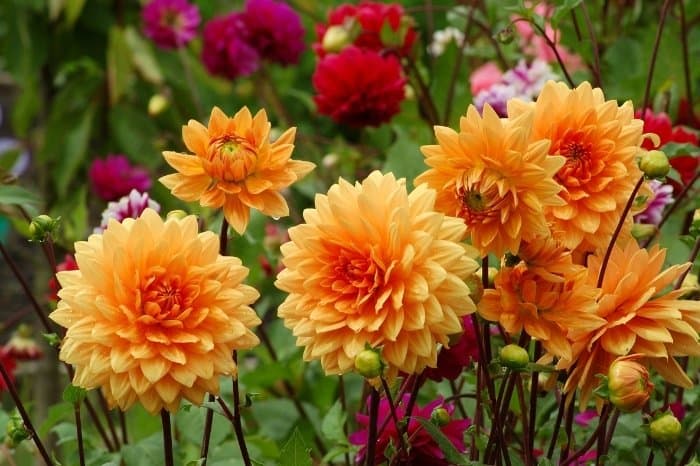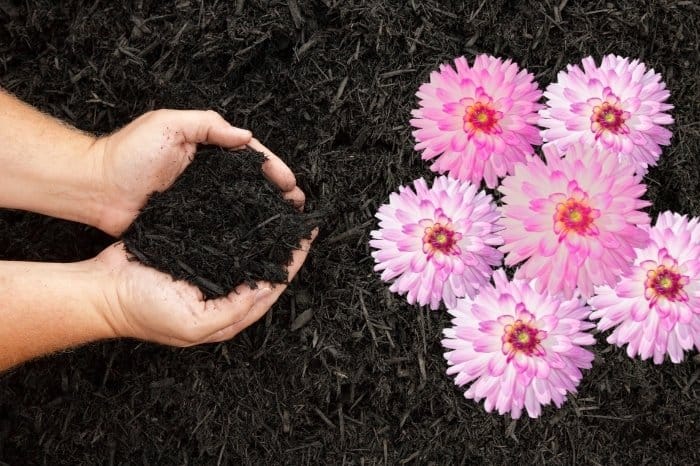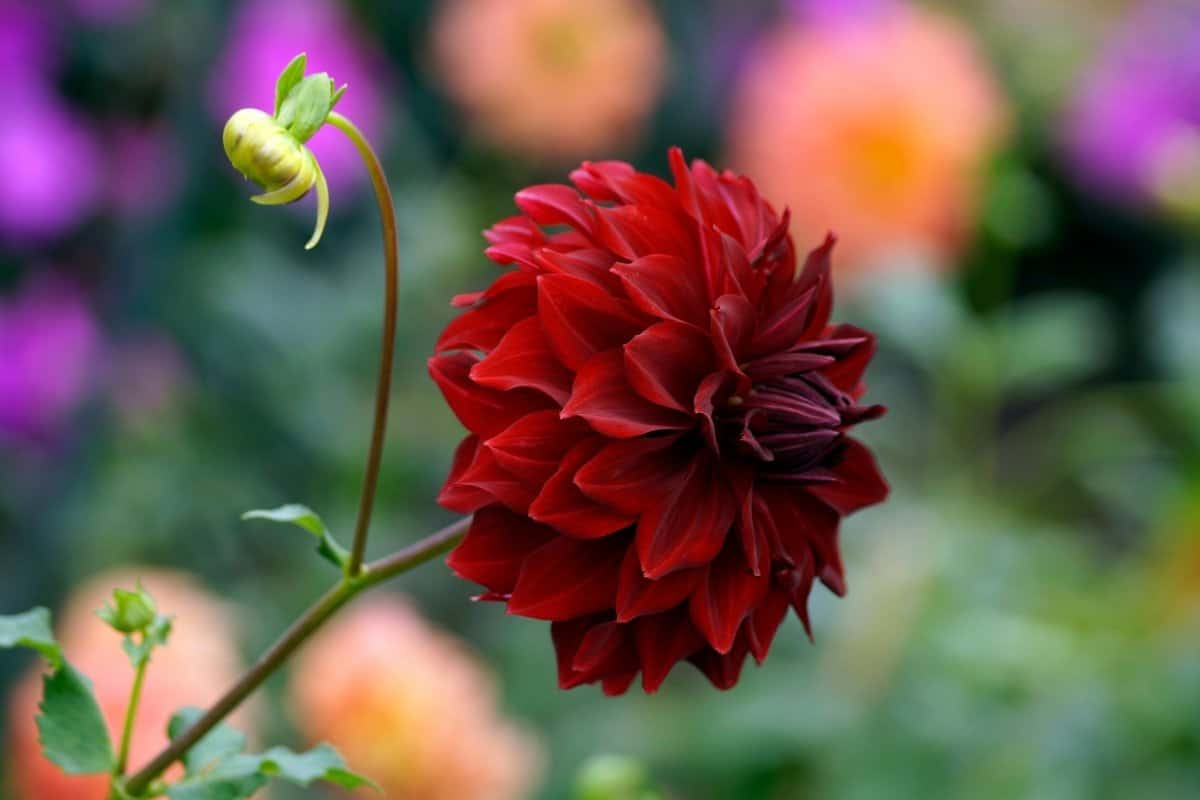Last Updated on February 7, 2022 by
Gardeners who want to know what conditions are best for growing this striking flower have asked dahlia sun or shade questions so many times.
With their striking, sculptural, beautiful flowers, dahlias bring a sentimental touch to your garden and home. They are so prevalent in floral arrangements; it’s no surprise that many dahlia enthusiasts seek to maximize on these blooms like no other.
A common question is how much sun or shade should you give these flowers. So are dahlias sun plants or shade plants?
The Perfect Dahlia Sun Or Shade?
Will dahlias thrive under the sun? Yes. Will dahlia thrive under the shade? Yes. So what’s the big deal?
Dahlia flowers are best grown in locations that receive over 6 hours of sunlight and can remain moist, not dry out or wilt. Too much sun can give rise to the dryness of your dahlia plants. So when it comes to growing a perfect dahlia, shade is part of its growth system.

Can Dahlias Grow In The Shade?
Dahlias are used to bright sunlight and warm weather, and most of them will do well in full sun. However, some varieties evolved as forest edge plants and only need a few hours of direct sunlight each day. Said, some types will be better in the shade than others.
If you buy Dahlias from a specialist grower, they will probably know which ones grow better in shade or sun. Ensure that you ask this question before you purchase any dahlia plant.
Dahlias Like It Warm, Not Too Hot
So how much sun for dahlias? Like most flowers, dahlias have been grown for a longer time. These flowers are native to the mountains of Southern Mexico and Central America, where summer days are warm up to 80 degrees F and nights are cool with 65 degrees F.
The growth conditions along the Pacific Northwest Coast are similar, which is why gardeners who live around that area grow such beautiful dahlias.
If temperatures get warmer during the day or night, dahlias may show signs of stress. Heat or cold stress causes these flowers to get stunted growth, poor flower production, misshapen flowers, and increased susceptibility to pests and diseases.
Hoffman 15503 Canadian Sphagnum Peat Moss, 10 Quarts
So Is The Full Sun Always The Best?
There is no doubt dahlias are sun lovers, and more sun for any flower farmer means more bloom. However, if the sun is too hot and the temperatures are too high, the plants may stop flowering.
Choose a planting location that offers half sun and half shade instead of the full-day sun to protect your dahlias from excess heat. Ideally, your plants will get full morning sun and shade in the afternoon. You can also plant these flowers beneath a shade tree. The overheard branches will protect the foliage from the afternoon’s hot sun and reduce the air temperature.
Read more about Zinnias Sun Or Shade – What Is The Best?
What If You Don’t Have Shade Where You Are Growing Dahlias?
If you have no shade where you are growing your dahlias and live in a hot climate, consider putting up a shade structure. It’s an ideal solution for gardens that do not have any shady areas.
To make your shade, use a polyethylene shade cloth that lasts for many years. Depending on the weave, you can filter out as little as 20% of the light or as much as 80%. If you give dahlias 40% of light, they will still thrive. This fabric also shields the flowers from the heavy rain and hail that could be damaging.
How Else Can You Cool Your Plants?
In case you are experiencing too much sun, it’s best to cool off your plants by mulching. Covering the soil with mulch will insulate the roots of these plants and help protect them from extreme heat.
Ensure that your mulch is no more than 2 or 3 inches thick, and it must allow water to flow through it to the soil. The best time to apply your mulch is early June when your plants grow strong and before it gets too hot.
Dahlia Sun Or Shade – The Right Balance
Most plants require the sun and water to thrive; however, the optimal amount of each depends on the individual plant. Many plants can flourish and do well in less than ideal conditions.
Even in these adaptable situations, flowering can be given a better positioning by the natural environment. Ensure for any plant you plant in the shade; you assess the amount of sun it will get and vice versa.
Soil, Organic Matter, And Proper Drainage
Besides the sun or shade needs, provide dahlias with plenty of organic matter and proper drainage. Dahlias prefer rich soil. Before you plant them, enrich your soil with a generous amount of compost, old manure, or shredded leaves. Loose soil that has been enriched with organic matter encourages strong root growth and absorbs moisture properly.
Plant your dahlias in well-draining soils to prevent your plants from being soggy and dying from too much water. Wet roots stress the plants causing the tubers to rot and the plants to die. If you notice your soil is naturally heavy, consider growing your dahlias in raised beds. This way, you can fill the beds with the best possible soil and ensure proper drainage always. Also, consider increasing dahlias in containers and fill them with a professional high-quality growing mix that has been amended with compost.

Watering Dahlias
Dahlias don’t like too much water, but drought can cause them to dry up and die. If natural rainfall fails or is inadequate, it’s best to water your dahlias deeply once a week rather than water them lightly several times per week.
The best watering method uses drip irrigation to keep the foliage dry and water the plants down to the roots with no runoffs. If you are hand watering, pour the water directly at the soil level to avoid getting the leaves and flowers wet to discourage mildew and mold growth.
FAQs
How do you keep zinnias blooming?
Zinnia plants are easy to grow and have colorful blooms. But it’s easy to kill them with too much water or not enough fertilizer. The good news is that there are a few tricks you can use to help keep your plants healthy and happy. If you’re looking for something to put in your garden, here are a few ways to keep zinnias blooming. 1.
Water and fertilize your zinnias. Zinnias need plenty of water but they also need nitrogen and phosphorus to grow properly. A zinnia plant has the ability to take nitrogen from the air and convert it into nitrogen-containing fertilizer for the leaves and roots. They also need phosphorus to make flowers and leaves.
Water deeply and frequently (at least twice a day). Pinch off tips or remove damaged leaves when necessary. Cut back on fertilizing if you see plants becoming leggy. When to Harvest You will know when your zinnias are ready for harvest by looking at them. You may also notice that the flower buds are beginning to turn yellow and drop off. The flowers will continue to drop off as they mature.
Can zinnias grow in shade?
They can grow, but not as well as in full sun. Zinnias are pretty hardy plants, so they can survive in cooler temperatures, but they won't do as well as if they were planted in full sun.
Should zinnias be in full sun?
Zinnias do just fine in full sun, as long as there is good drainage. If you don't have that, put some sort of mulch around the base of the plant.
How many hours under the sun do zinnias need?
Zinnias are best grown in full sun, but will tolerate light shade. They will not tolerate deep shade, and may need to be moved during the hottest parts of the day if they get too much direct sun. In general, zinnias can take at least 6 hours of direct sunlight per day.
What do you do with zinnias at the end of the season?
We usually let them go to seed in the garden, and then plant them again next year. But if they are planted outside of the garden, we often toss them into the compost pile.
Should I start zinnias indoors?
Do not starting the zinnias indoors, because they will not produce until after the last frost.
When is the best time to plant them?
Zinnias are a great choice for fall planting. They are easy to grow, don't need much care and come in many varieties. The best time to plant zinnias is in the spring, but they can also be planted in the fall.
Conclusion
FAQs
How do you keep zinnias blooming?
Zinnia plants are easy to grow and have colorful blooms. But it’s easy to kill them with too much water or not enough fertilizer. The good news is that there are a few tricks you can use to help keep your plants healthy and happy. If you’re looking for something to put in your garden, here are a few ways to keep zinnias blooming. 1.
Water and fertilize your zinnias. Zinnias need plenty of water but they also need nitrogen and phosphorus to grow properly. A zinnia plant has the ability to take nitrogen from the air and convert it into nitrogen-containing fertilizer for the leaves and roots. They also need phosphorus to make flowers and leaves.
Water deeply and frequently (at least twice a day). Pinch off tips or remove damaged leaves when necessary. Cut back on fertilizing if you see plants becoming leggy. When to Harvest You will know when your zinnias are ready for harvest by looking at them. You may also notice that the flower buds are beginning to turn yellow and drop off. The flowers will continue to drop off as they mature.
Can zinnias grow in shade?
They can grow, but not as well as in full sun. Zinnias are pretty hardy plants, so they can survive in cooler temperatures, but they won't do as well as if they were planted in full sun.
Should zinnias be in full sun?
Zinnias do just fine in full sun, as long as there is good drainage. If you don't have that, put some sort of mulch around the base of the plant.
How many hours under the sun do zinnias need?
Zinnias are best grown in full sun, but will tolerate light shade. They will not tolerate deep shade, and may need to be moved during the hottest parts of the day if they get too much direct sun. In general, zinnias can take at least 6 hours of direct sunlight per day.
What do you do with zinnias at the end of the season?
We usually let them go to seed in the garden, and then plant them again next year. But if they are planted outside of the garden, we often toss them into the compost pile.
Should I start zinnias indoors?
Do not starting the zinnias indoors, because they will not produce until after the last frost.
When is the best time to plant them?
Zinnias are a great choice for fall planting. They are easy to grow, don't need much care and come in many varieties. The best time to plant zinnias is in the spring, but they can also be planted in the fall.
Dahlias are beautiful flowers to grow with low maintenance and growing requirements. Growing them under balanced sun or shade will result in a good harvest of these beauties.
Caroline is a gardener who loves to get down to the nitty–gritty of gardening. She proudly proclaims herself as a ‘dirt worshipper‘ and can often be found deep in the garden, covered in soil and singing to her plants. As a self–proclaimed ‘plant whisperer‘, Caroline believes that plants need love and attention just like any other living thing, and she loves to give them both. When she‘s not tending to her garden, you can often find her researching the latest gardening trends, or teaching others how to make their gardens thrive



